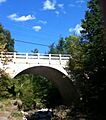List of bridges on the National Register of Historic Places in Vermont facts for kids
Vermont is home to many amazing bridges and tunnels that are so special, they've been added to a list called the National Register of Historic Places. This list helps protect important places in the United States so future generations can enjoy them. Think of it like a hall of fame for historic buildings and structures!
Many of these historic structures in Vermont are bridges, especially old covered bridges. These bridges are like time capsules, showing us how people built things long ago.
Contents
What Makes a Bridge Historic?
A bridge gets on the National Register of Historic Places because it's important to history, architecture, or engineering. It might be very old, built in a unique way, or connected to an important event. When a bridge is listed, it means it's recognized as a valuable part of our past.
Vermont's Famous Covered Bridges
Vermont is well-known for its beautiful covered bridges. These bridges have roofs and sides, which helped protect the wooden parts from rain and snow. This made them last much longer. Many of the bridges on Vermont's historic list are covered bridges.
Different Styles of Covered Bridges
Covered bridges aren't all built the same way. They use different "truss" systems, which are like the hidden skeletons that hold the bridge up. Here are a few types you might find in Vermont:
- Town lattice truss: This design uses many crisscrossing wooden planks, making a strong, web-like pattern. Many Vermont covered bridges use this style, like the Arlington Green Covered Bridge built in 1852.
- Queenpost truss: This is a simpler design with two main vertical posts and a horizontal beam. The Bradley Covered Bridge from 1878 is an example of this type.
- Burr arch truss: This style combines a strong arch with a truss system, making it extra sturdy. The Great Eddy Covered Bridge from 1833 uses this design.
Bridges That Faced Challenges
Some of Vermont's historic bridges have faced tough times, like floods or fires, but many have been rebuilt or saved.
- The Bartonsville Covered Bridge was built in 1871. Sadly, it was destroyed by flash flooding from Hurricane Irene in 2011.
- The Bedell Covered Bridge, built in 1866, was also destroyed by a strong windstorm in 1979.
- The Bowers Covered Bridge was washed 200 feet downstream during Hurricane Irene in 2011, but it was later rebuilt!
- The Dean Covered Bridge (around 1840) was sadly destroyed by an arsonist in 1986.
- The Middlesex-Winooski River Bridge, a Pratt through truss bridge from 1928, was also destroyed by Hurricane Irene.
- The Mill Covered Bridge (1883) was destroyed by ice in 1999 but was replicated and rebuilt in 2000.
- The River Road Covered Bridge collapsed in 2021 due to fire damage.
- The Swanton Covered Railroad Bridge (1898) was destroyed by arson in 1987.
- The Waterman Covered Bridge (1868) collapsed in 1982 and was then demolished.
- The Woodstock Warren Through Truss Bridge was swept away by Hurricane Irene.
These stories show how important these bridges are to the communities, as many were rebuilt after being damaged.
Other Types of Historic Bridges
While covered bridges are famous, Vermont also has other types of historic bridges on the list:
- Metal Truss Bridges: These bridges use strong metal beams arranged in a pattern to support the weight. Examples include the Bloomfield-Nulhegan River Route 102 Bridge (a Pratt through truss) from 1937 and the Douglas & Jarvis Patent Parabolic Truss Iron Bridge (1887).
- Stone Arch Bridges: These beautiful bridges are built from stones shaped into an arch. The East Putney Brook Stone Arch Bridge (1902) and the Sacketts Brook Stone Arch Bridge (1906) are great examples.
- Concrete Bridges: Modern bridges also become historic! The Middlebury Gorge Concrete Arch Bridge (1924) is a reinforced concrete bridge.
Why Are These Bridges Important?
These historic bridges are more than just ways to cross a river. They are important because:
- They show us how engineering and building methods have changed over time.
- They are often beautiful landmarks that add to Vermont's unique character.
- They connect communities and have been used by generations of people.
- They remind us of the past and the hard work that went into building our infrastructure.
By being on the National Register of Historic Places, these bridges get special attention and care, helping to make sure they can be enjoyed for many more years.
Images for kids
See also







































































































































